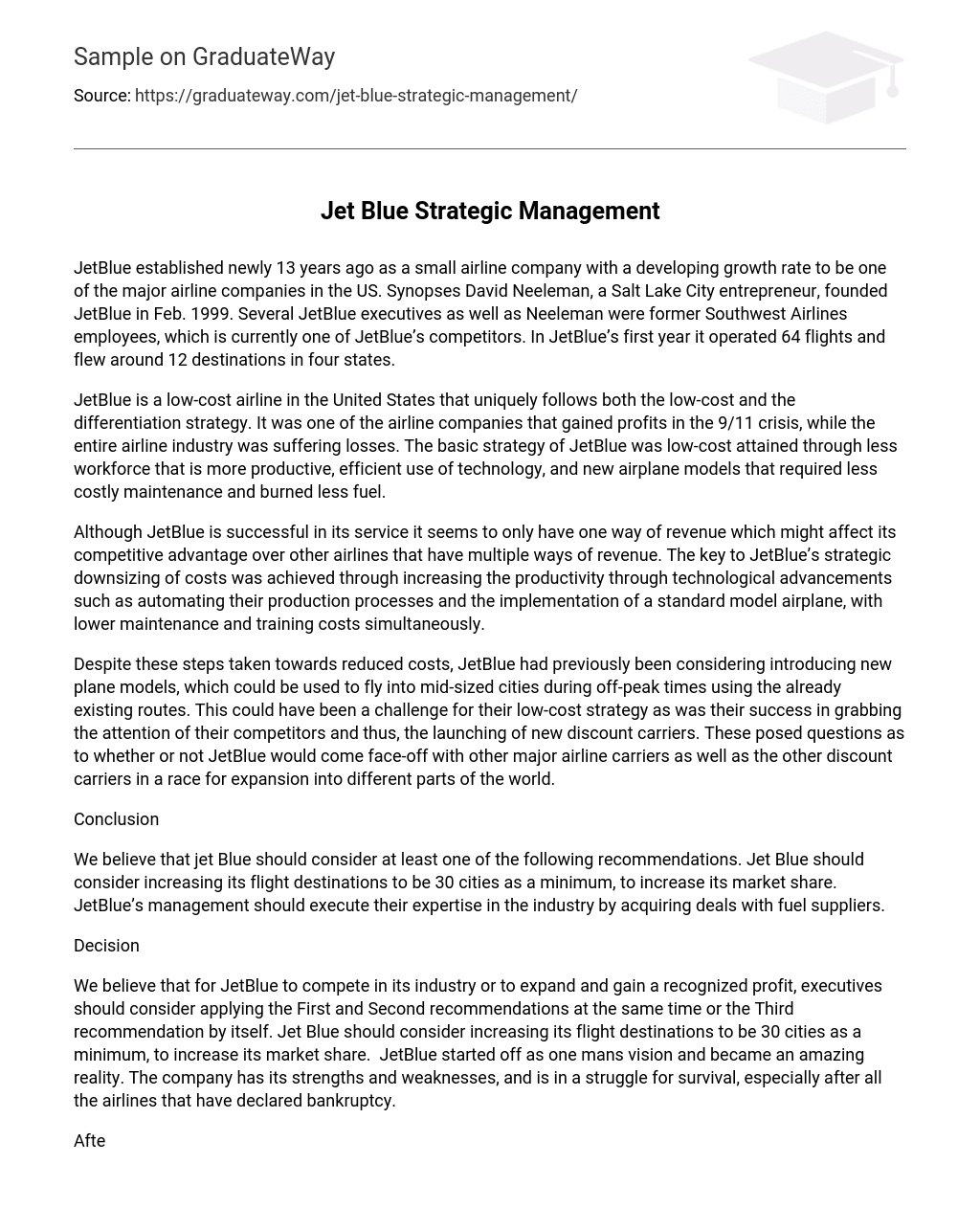JetBlue established newly 13 years ago as a small airline company with a developing growth rate to be one of the major airline companies in the US. Synopses David Neeleman, a Salt Lake City entrepreneur, founded JetBlue in Feb. 1999. Several JetBlue executives as well as Neeleman were former Southwest Airlines employees, which is currently one of JetBlue’s competitors. In JetBlue’s first year it operated 64 flights and flew around 12 destinations in four states.
JetBlue is a low-cost airline in the United States that uniquely follows both the low-cost and the differentiation strategy. It was one of the airline companies that gained profits in the 9/11 crisis, while the entire airline industry was suffering losses. The basic strategy of JetBlue was low-cost attained through less workforce that is more productive, efficient use of technology, and new airplane models that required less costly maintenance and burned less fuel.
Although JetBlue is successful in its service it seems to only have one way of revenue which might affect its competitive advantage over other airlines that have multiple ways of revenue. The key to JetBlue’s strategic downsizing of costs was achieved through increasing the productivity through technological advancements such as automating their production processes and the implementation of a standard model airplane, with lower maintenance and training costs simultaneously.
Despite these steps taken towards reduced costs, JetBlue had previously been considering introducing new plane models, which could be used to fly into mid-sized cities during off-peak times using the already existing routes. This could have been a challenge for their low-cost strategy as was their success in grabbing the attention of their competitors and thus, the launching of new discount carriers. These posed questions as to whether or not JetBlue would come face-off with other major airline carriers as well as the other discount carriers in a race for expansion into different parts of the world.
Conclusion
We believe that jet Blue should consider at least one of the following recommendations. Jet Blue should consider increasing its flight destinations to be 30 cities as a minimum, to increase its market share. JetBlue’s management should execute their expertise in the industry by acquiring deals with fuel suppliers.
Decision
We believe that for JetBlue to compete in its industry or to expand and gain a recognized profit, executives should consider applying the First and Second recommendations at the same time or the Third recommendation by itself. Jet Blue should consider increasing its flight destinations to be 30 cities as a minimum, to increase its market share. JetBlue started off as one mans vision and became an amazing reality. The company has its strengths and weaknesses, and is in a struggle for survival, especially after all the airlines that have declared bankruptcy.
After reading and analyzing the case, and with the help of industry frameworks, we were able to reach some conclusions that will benefit JetBlue. After reading and understanding the case, we developed a SWOT analysis and put ourselves in the position of JetBlue’s top management, from then we were able to map strengths, weaknesses, opportunities, and threats. We began developing recommendations and long-term objectives for the company that would best suit their current state. Amongst some of these were for JetBlue to invest more in customer relations, employ more agents, develop marketing strategies, and increase hedges on fuel from suppliers.
We then used Porters five forces to get a better understanding of the airline industry, its barriers, buyers and suppliers’ power, substitutes, and rivalry amongst competitors. After completing both frameworks we were able to understand where JetBlue stands as a company right now, and what it needs to continue its success. We then came up with recommendations that will help solve some, if not all, of the company’s current issues. The following is a list of our recommendations for JetBlue: n JetBlue should consider increasing its flight destinations to 30 cities as a minimum in order to increase its market share n JetBlue’s management should execute their expertise in the industry by acquiring deals with fuel suppliers. n JetBlue should expand internationally and operate in the Middle East.
The fact that it has low private company regulations and easy passed transactions, highly developed communication and transportation facilities, and that it has no Headquarter of any operating Region specific airlines such as: Qatar and Kuwait, in addition to that it is located in the middle of the Arabian Gulf we believe that it is the most attractive country. UAE was an average rated economy due to the schedule studies. Due to the fact that it has State Governors conflicts, Land owning historical problems, and the Economical cons, we believe that to invest in UAE a lot of specific studies on each State should be done by JetBlue research Department before showing interest in the country itself to be a location for its headquarters. Kuwait was below average due to the ratings and studies.
It has Rules and Regulations against foreign investments and foreigners can’t own land due Kuwait’s rules and regulations. In addition Kuwait has an established regional Airline company Wataniya. Qatar was the country that JetBlue should avoid do to the studies we made. It has a low population which might decrease its local customers, foreign investors should use a Joint Venture to enter Qatar, non-citizen’s cant own land in Qatar, and finally Qatar also had a well established regional airplane company which is Al Jazeera. Recommendation and Decision JetBlue should expand internationally and operate in the Middle East with Bahrain as their headquarters.





